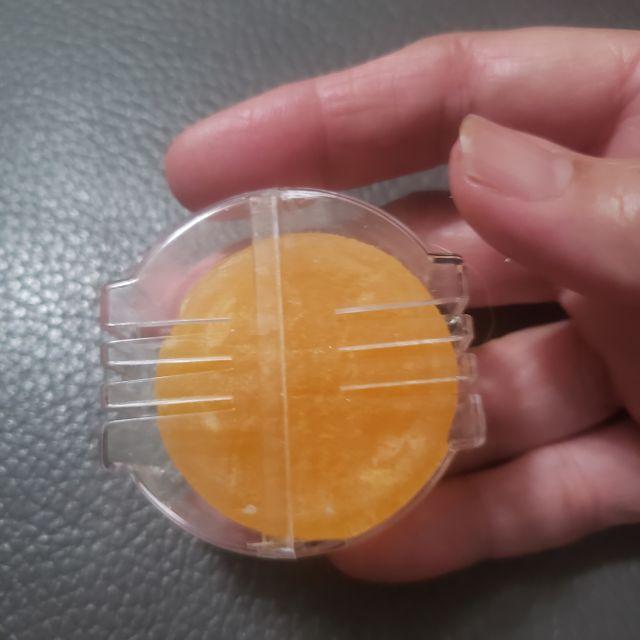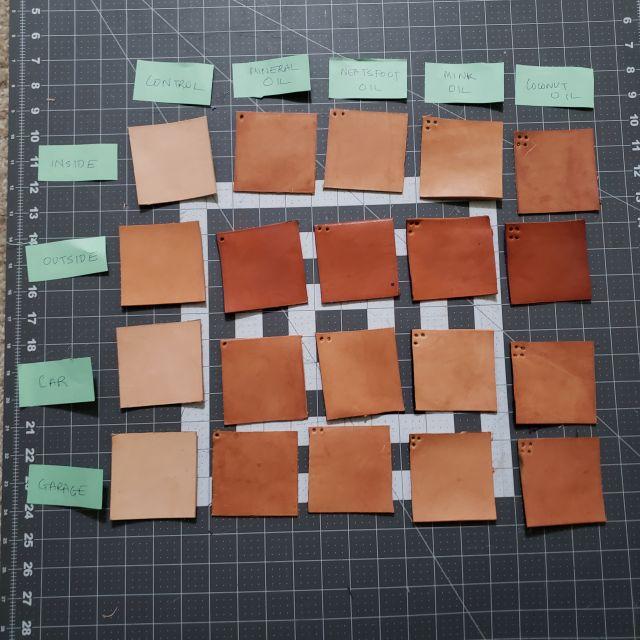-
Posts
1,283 -
Joined
Content Type
Profiles
Forums
Events
Blogs
Gallery
Everything posted by SUP
-

Leather Splits- uses, some feedback please
SUP replied to gkyork's topic in Leatherwork Conversation
Yes you understood correctly. I meant burnishing the surface of the splits. The split I have, even on the smooth side, is rougher than the grain side of full or top grains. Water burnishing works but needs a lot of elbow grease to buff; less so with Tokonole. Mop-n-glo I have heard of as a sealing agent. I have no experience with it so do not know if it can be used here as a burnishing agent. Maybe someone else here will give you that information. Other burnishing agents are gum trag, beeswax, saddle soap. However, most of these, including Tokonole, might make casing to tool or carve or dyeing difficult as they, except for saddle soap, as far as I know, all resist water. So burnishing with water/saddle soap or burnishing after dyeing and then cutting might be a way out.- 10 replies
-
- project ideas
- new guy
-
(and 1 more)
Tagged with:
-

Leather Splits- uses, some feedback please
SUP replied to gkyork's topic in Leatherwork Conversation
Some of the high-end leathers like Saffiano are splits with additional layers of synthetics on them. I have heard others are too, but do not know which ones. I have no idea of their strength either. They could hold up or it could be that being so expensive, people who buy items made from such leathers are just more careful with them. I have a split from Springfield, a large, stiff, heavy one. I discovered that pieces of it make great 'poundo' boards - much kinder on my chisels and punches. I keep it on a block of wax which is itself placed on a granite slab. Works well for me. The split soon becomes weak and floppy where I punch on it though. Whether all leathers do that so easily or splits are weaker, I do not know. I just replace it as needed. I also use it to practice stitching and checking dyes. One side of the split is relatively smooth , I used water and burnished it and plan to practice tooling on it. I did not use Tokonole as I plan to dye it as well. Tokonole would probably give it a good shine and finish. The split that I have is too heavy for using as a support for floppier leathers. But I know there are items made with plain splits. I have a tool kit made with split leather - the type where you place the tools in little slots and roll, so it is very flexible. It is smooth on both sides but it has not been burnished or dyed - it is a plain untreated split. If that is possible, i see no reason why you should not be able to make pouches and bags, if your splits are of the appropriate temper. You could try burnishing them with Tokonole first, to ensure they can be made to look presentable. Any burnishing agent should work, not necessarily just Tokonole. Hope that helps a bit.- 10 replies
-
- project ideas
- new guy
-
(and 1 more)
Tagged with:
-

Allergies in dogs and their going off food.
SUP replied to SUP's topic in All About Us and Off Topic
When I see people breeding dogs and cats for specific things, it infuriates me. Let them continue to evolve the way they have through the years and stop getting exaggerated forms of anything -noses, backs, whatever. Unless it is for health, it is not right. Pure breeds bred with care and integrity are fine but all those naked cats and Persians with scrunched up noses like the Bulldogs and all that is explained so much in detail here are nightmares! I remember in 2003, having a long discussion with my Genetics professor about how such selections of specific features and characteristics through genetic manipulation would be possible in humans by 2020. I had thought it would not happen until at least 2040 - good to be proven right about humans. - in dogs and cats, it's been happening all through, in a rough and haphazard way.. Can see it happening in humans as well - blue eyed babies, babies with big butts, babies with... you get the picture. I suspect 'intelligence' will be the least in demand. I, for one, always get my pets from shelters and they have always been darling; would not win prizes at shows but are our babies and perfect for us. Our current dog, Pepper, wants to be a cat - after seeing our now deceased cat filling soil post-poop, she does the same! Only she wisely does it some distance away, while mom or dad pick up after her! Then sneezes all the way home. Ordered some face masks for her. Only found one seller. Let's see if she agrees to wear them. -
Thank you @Burkhardt. @packjac I was worried about rancidity too and very few oils stink as much as rancid coconut oil. But guess what? It did not turn rancid in my experiment. There is no smell at all. It will be nice if you could upload photographs of your leather with the olive oil on the thread of our experiments as well. The more people who contribute, the more the information gained.
-

Allergies in dogs and their going off food.
SUP replied to SUP's topic in All About Us and Off Topic
@nstarleather I know! Our fur-babies are our babies, just as much as our human ones. I certainly worry as much about my furry and feathery babies. Talk to them like to humans too.. People think I am touched in the head! LOL, but I don't care. They understand and respond and that is what matters. My poor dog still coughs and sneezes when we take her for walks, even with the antihistamines. I wipe her clean as soon as she comes home but she still snuffles for a while. So I am thinking of a face mask for her. Looking for one, though I am not sure she will agree to wear it. It needs to keep out the pollen but allow her to sniff and smell everything. -

Allergies in dogs and their going off food.
SUP replied to SUP's topic in All About Us and Off Topic
I plan to change her allergy meds periodically. That might be effective for her, just like it often is for us, humans. -
Have you looked in Etsy? They have a very large number of patterns for leather items and might have one for this as well.
-
A bit late in the thread. but these days, whenever I cut any leather, I try to keep the edges intact. Since I normally cut as near the edge of the larger leather as I can anyway, I get some thin, long sections, too thin to make belts or straps. If I get a continuous one, it's great. Else I just sit with scissors and cut them into long strips - lace I suppose, but not particularly well done, since they are not really long enough to use as lace for anything that I make and are usually the edges, so not smooth or clean enough in texture. But, I use these strips of long and short laces to tie just about anything that needs tying in the house, from leather rolls, to .packets of food to bread packets to even my hair at a pinch. We rarely use thread any more. Also, while cutting repeated pieces, I try to keep areas in between to some symmetry so that I can then make keychains or zipper tags with those pieces. Just been making loads of keychains for gifts for dozens of people, so thought of that. Key chains are an unexpected bonus, almost automatically formed and less headache of wondering what to do with all the small pieces left behind! Also, if I cut really close, I still get that lace anyway, the lace that I use for tying. This I guess everyone does but I thought to mention it anyway.
-

Allergies in dogs and their going off food.
SUP replied to SUP's topic in All About Us and Off Topic
Yes. They take a while to get back to their normal routine. My dog still has congestion, just not so much. The vet says it just has to be endured, like we all do. Allergies are the worst here, with all the vegetation. -
@TomE if the crystals don't form with this method, that is great. I did not like the idea of so much kneading. Thank you for that information.
-
My dog has severe allergies and coughs and sneezes every time we take her for walks. So she is on baby Claritin - prescribed by her vet - which really helps - not 100% but quite a bit. We ran out of Claritin 2 days ago and missed a dose. The allergies of course promptly returned. She also stopped eating - a worry that occurs periodically. Now I realized she goes off her food when her allergies act up because she gets a stuffy nose and cannot smell anything. With such a sensitive sense of smell, that must be awful! Anyway she got her Claritin dose and I led her to her food - milk first. She looked so delighted to be able to smell it again and had her meal - a relief. Just thought I would put this up here in case anyone else has pets with a similar problem.
-
@fredk charming song, morbid theme notwithstanding - googled it as I could not catch the words - lovely accent though. @dikman, there is a mention that it needs constant kneading because otherwise the rosin will form crystals in the wax. So would not pouring it into molds allow crystallization as well?
-
To do what @@chuck123wapati says, you get straight line punches as well, which do the same and they are not expensive. You should get them on Amazon.
-
Who Indeed. So you can use either for making hand wax? I was looking it up - it appears their methods of production are different as well - that is when they are sold packaged. If you don't collect your own...which I can't , and need to buy it, is resin better or rosin, to make hand wax?
-
Are resin and rosin two names for the same thing or are they different things entirely?
-
@fredk LOL sounds familiar. I have made my reputation by losing a huge role of paper. I keep all small thingamabobs below 1-2 inches in size in one box - of which hubby knows the location. So things are getting lost less often. @TomE I have to try that!
-
Found a nifty little tool on Temu recently, for waxing thread as you use it. No idea how it will work for those of you working on larger projects, but for me, with my small projects, it works fine. You get it with white and yellow wax and cost me less than a $1.5. Making those little discs of wax should be simple for those who want their own mix in there. I though the container is useful.
-
After all the fuss so many make about mineral oils being bad for leather, in my experiment at least, ,up to this point, mineral oil seems to have the best effect on leathers. Good. It's cheap, no odor, non-poisonous and abundantly available. I will continue this experiment but will certainly use it in my leather preparations without needing to wonder about its safety or efficacy any more.
-
Not forgotten! Sunday today and decided to take a break from gift making. Two and a half months on, here are I am, with a photograph of the effects of the oils. I used mineral oil, mink oil, coconut oil and neatsfoot oil. These are my observations for today: Mineral oil kept the leather the softest. The leather has a smooth feel throughout, and is not warped, except for the piece left outside which is very slightly curved at the edges but still feels smooth and supple. Coconut oil kept the leather nearly as soft and smooth as mineral oil. It darkened the most of all the oils, although this is not very clear in the photograph. Also, no smell at all. Mink oil dried the most and caused the most warping in all locations. It also darkened the least in all locations. Neatsfoot oil fell somewhere in between, dried but not as much as mink oil, darkened but not as much as coconut oil. Controls: As expected, they dried a little over time, drying more outside and in the car than inside or in the garage. Also curved at the edges as they got a little dry. Regardless of the oil, the pieces kept outside darkened significantly, including the control; the coconut oil darkening the most; mink oil darkened the least. So oiling is not needed to darken leather when kept in the sun but without oils, leather darkens only slightly. with oils, it darkens to a deep, rich color, even without dyes. I do not plan to re-oil the leather as yet. I keep planning to add more oils to test but hate the thought of a bigger grid, more conclusions to work towards. Just being lazy I guess.
-
@fredk I suspect some of the people here are truly perplexed about his stubbornness in the face of so many good experiences and proof with M&G and his refusal to even consider it while others just enjoy needling him a bit.
-
That is beautiful. Such beautiful stamping! It is very unusual, your pattern. Lovely piece of work.
-
The basket weave is stunning and eye-catching. I feel that if you had used a thinner thread, it would have appeared unbalanced. I think unconsciously you used the correct thickness. Your stitching is neat and even too, so it complements the stamping well.
-
@Wepster I once dropped half a litre of oil on a new dress! Covered it in talcum powder, and added fresh lot several times as it got saturated. The dress was clean in 2 days! I had completely forgotten until you mentioned it here. @fredk thank you for mentioning talcum powder here. Now I can get it and keep it ready for so many uses, including giving a matte finish to leather. So no Baby powder - pure talc is probably better - via the ubiquitous Amazon.
-
@DocReaperNo offense taken. We all have our own opinions. The second part, I agree, which I why I said what I did. In spite of voting blue! imagine!




